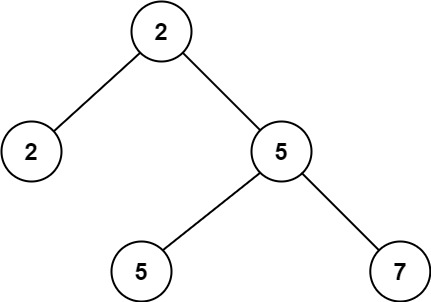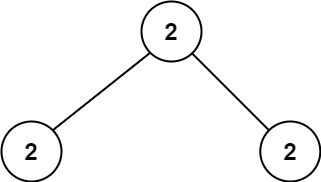Problem
Given a non-empty special binary tree consisting of nodes with the non-negative value, where each node in this tree has exactly two or zero sub-node. If the node has two sub-nodes, then this node’s value is the smaller value among its two sub-nodes. More formally, the property root.val = min(root.left.val, root.right.val) always holds.
Given such a binary tree, you need to output the second minimum value in the set made of all the nodes’ value in the whole tree.
If no such second minimum value exists, output -1 instead.
Example 1:

1 | Input: root = [2,2,5,null,null,5,7] |
Example 2:

1 | Input: root = [2,2,2] |
Constraints:
- The number of nodes in the tree is in the range
[1, 25]. 1 <= Node.val <= 231 - 1root.val == min(root.left.val, root.right.val)for each internal node of the tree.
Analysis
题目给出一颗二叉树,要求找到整棵树中第二小的元素。因为是easy题,所以可以直接对整棵树做一次搜索,把所有的元素都存到一个unordered_set中,最后在这个集合中找到第二小的元素。
但其实这里还有一种稍微好一点的方法,虽然复杂度上并没有不同,但是空间复杂度是function stack的复杂度,因此理论上会更快。题目虽然给的是普通的二叉树,但是也有一些特点,根节点是整颗子树中最小的元素,所以整棵树最小的元素就是根节点root->val,记录为minVal。紧接着我们可以做一个前序遍历,如果当前节点的值比minValue大,说明它有可能是第二小的,于是和result比一下,取较小值,之后就不需要再递归下去了,因为这个以这个节点为根的子树的值只会比当前节点的值大,不可能是第二小的数;如果当前节点的值等于minValue,说明以当前节点为根的子树中可能存在第二小的数,于是递归左右子树。
Solution
这道题目还要处理答案不存在的情况,我们把result初始化为LONG_MAX,因为节点的值可能到达INT_MAX。
Code
1 | /** |
Summary
这道题目是二叉树中比较有意思的变种,虽然它给的不是BST,但是它的一些特性还是能够帮助我们更快地解题。这道题目的分享到这里,感谢你的支持!

